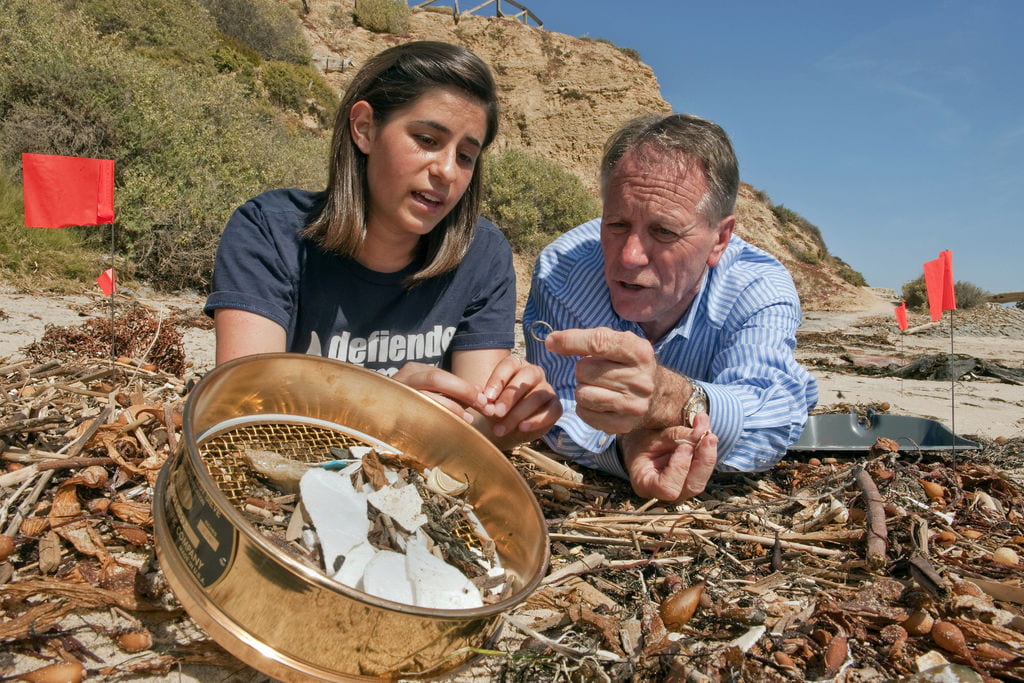Fighting the ocean's plastic pollution
UC Irvine professor William Cooper follows the trail of plastic debris that’s spreading from the coast to the deep sea.

On a clear spring day at Crystal Cove State Park, UC Irvine professor William Cooper and undergraduate Tova Handelman sift though a mound of seaweed and sand, oblivious to the curious stares of beachgoers. They’re too busy studying trash.
“Look at all this plastic!” says Cooper, picking out a pellet no bigger than a grain of rice from his growing pile. “This is a ‘nurdle.’ They’re used to make plastic products. They shouldn’t be on the beach, but if you look closely, they’re all over.”
Handelman looks grim. With Cooper as her adviser, she did her undergraduate research project on marine debris before getting her bachelor’s in social ecology this month.
“Fish and turtles eat those because they look just like fish eggs,” she says. “Their stomachs fill up with plastic, and they starve to death.”
Cooper, director of UCI’s Urban Water Research Center and civil & environmental engineering professor, studies the plastic debris proliferating in the ocean, from the coastline near campus to the deep sea where swirling islands of trash have formed.
He and his students count and catalog plastic trash to document what kind of waste ends up in the ocean and determine how rapidly the debris fields are growing. In February, his team went to Crystal Cove — between Corona del Mar and Laguna Beach — after heavy rains to see how much plastic had been deposited on the beach by churned-up tides and overflowing storm drains and rivers.
“I’ve never seen the beach so full of plastic,” he says. “It was horrible.”
They picked up bottle caps, popped balloons, cigarette lighters (which can choke birds that mistake them for small fish), Barbie doll legs, a toothbrush, a hotel room card key, tennis balls, and even a Furby.
“You can get just about anything you want at the beach,” Cooper notes drily.
It’s the same stuff he’s seen floating in the remote ocean, swept out from the mainland. Last July, he joined the Long Beach-based Algalita Marine Research Foundation on a voyage to gauge the scope of the Great Pacific Garbage Patch, a vortex of waste trapped by wind and ocean currents in the North Pacific Gyre northeast of Hawaii. It’s the largest of five pollution gyres in the world’s oceans.
“We were counting the amount of plastic going under our boat,” Cooper recalls. “In 10 minutes, we counted 145 pieces. There are tons of it out there.”
A racing skipper and former U.S. army captain, Cooper is well suited to the rigors of sea research. In October, he sailed to the Atlantic Garbage Patch, a plastic stew floating off the coast of Bermuda, and will return this summer to see if the debris field has grown.
Plastic waste poses a growing threat because it lasts forever. Plastic products don’t biodegrade, but they can break down into small pellets that mimic zooplankton, near the bottom of the food chain.
“About 1 million seabirds and 100,000 sea mammals and turtles are killed each year because they ingested plastics or got trapped in nets or other debris,” Cooper says.
At Crystal Cove, Handelman picks up a small O-ring, a rubber or plastic gasket that turns deadly in the ocean.
“Baby turtles stick their heads in them, and when the turtles grow, they suffocate,” she says. “The rings strangle them. It’s very sad.”
Some researchers and environmentalists worry that as plastic makes its way up the food chain, humans also will be at risk. Eating fish that have eaten plastic could expose people to harmful chemicals like polychlorinated biphenyls that have been linked to liver damage, severe rashes and cognitive impairment in children.
Cooper says the key to protecting marine life, and humans, is to change people’s attitude toward the ocean.
“The problem is they’re disconnected from the environment, so they don’t respect it,” he says. “Plastic pollution is the No. 1 indicator of how apathetic we’ve become about the planet.”
Cooper has become a busy advocate for ocean cleanup. He has taken sixth-graders on field trips to Crystal Cove for a firsthand look at plastic debris; has conducted an Osher Lifelong Learning Institute seminar on plastic for a course on “Ocean Health”; and is working on a documentary about the dangers of plastic waste.
“Our idea isn’t to try to stop people from using plastic,” he says. “It’s getting them to use less of it and to recycle. And it’s getting manufacturers to develop biodegradable products.” These would decompose in the environment, not form toxic islands in the sea.
“People think the ocean is infinite, but it’s not,” Cooper says. “If we don’t stop abusing it, we’ll kill it — and all life depends on it.”